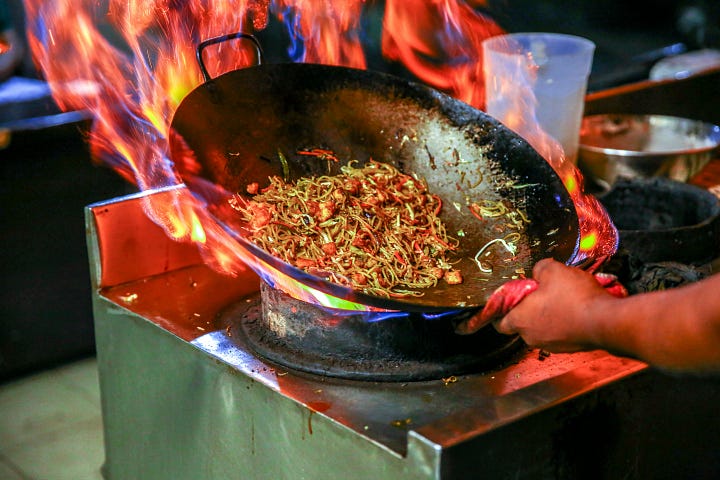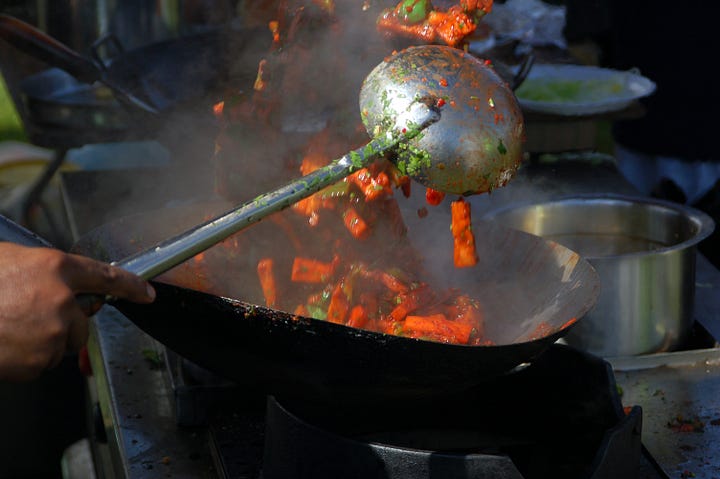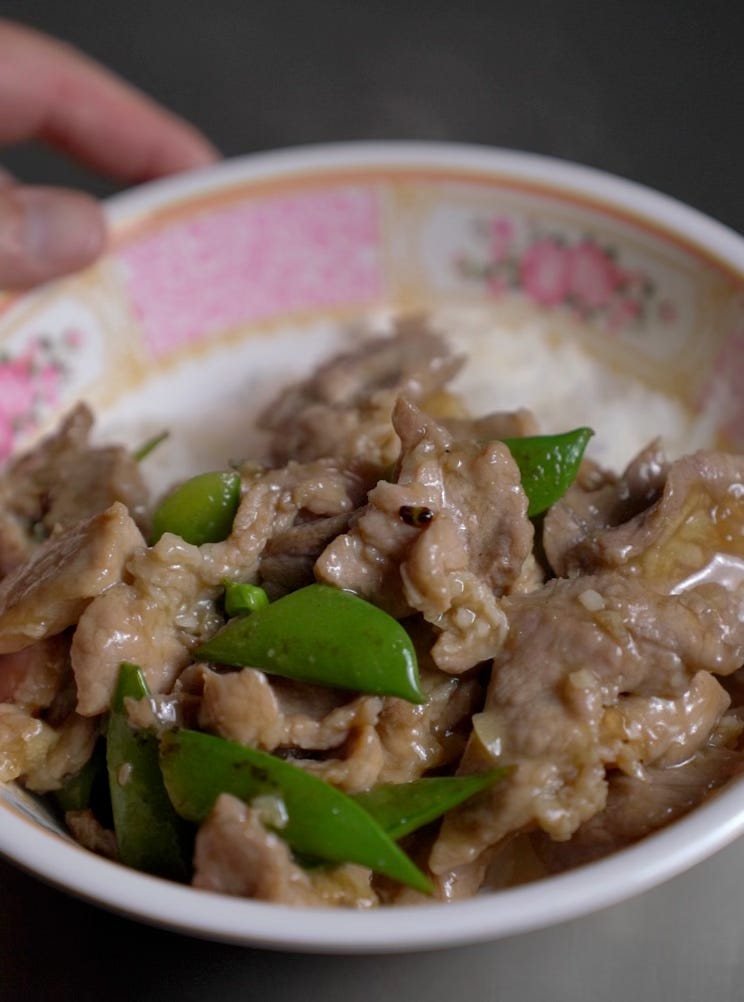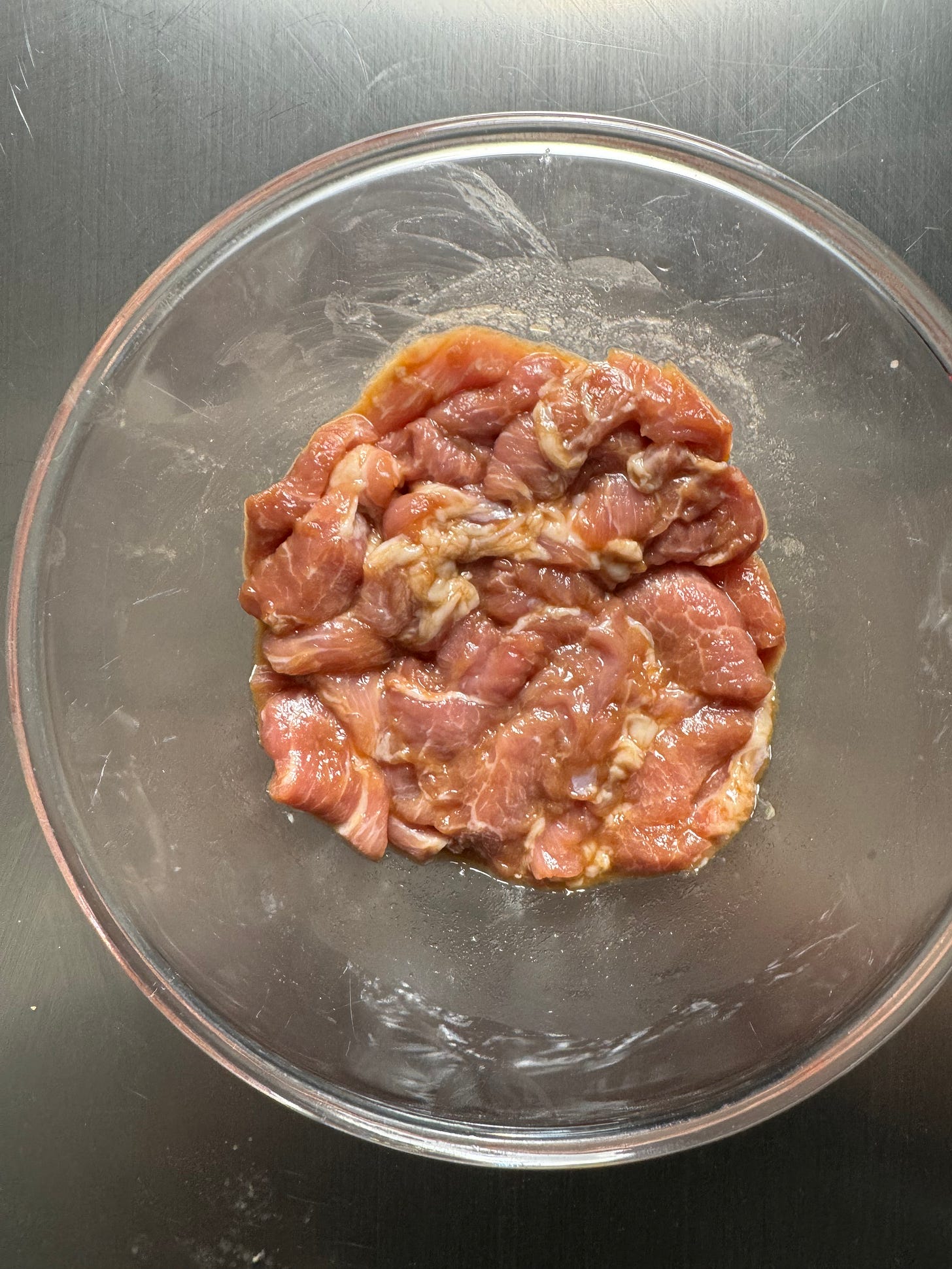On Stir-Frying, Meat Velveting, and Simple Sauces
Plus an everyday recipe for pork stir-fried with snap peas
It's taken me many years to learn how to make a good Chinese stir fry. It seems strange, but if I deem 'good' as comparable to, or better than, an average Chinese restaurant (in the UK or Australia), then it is undoubtedly true.
Within the Western lexicon, 'stir-fry' has become a catch-all phrase encompassing virtually any dish where ingredients are thrown into any which pan and mixed together. And whilst the term has become a little fast and loose, I'm here for it because I feel that the humble stir-fry, be it reflective of a 'proper' stir-fry or not, has become a beloved emblem of culinary ease and convenience all across the Western world.

At the same time, I am more interested in stir-fry stir-fries, the sort that resembles the method of cooking borne out of Chinese food traditions—ones made with high heat and a wok. So, it is through this lens that I write this article.
Yet, even through this lens, a stir-fry is ostensibly simple. The preparation time is minimal, and on the surface, the cooking technique is fairly rudimentary. However, the dish is a little harder to master than it appears. I would bet that most average punters following a decent recipe would fail to produce a great dish.
Whilst even in the Chinese tradition, stir-frying encapsulates a variety of dishes, from simple vegetable dishes to twice-cooked meat dishes, noodle stir-fries, and the ever-popular fried rice dishes, in the context of this article, I am focusing on a common type of stir-fry—the velvet stir-fry, wherein incredibly tender meat is stir-fried with typically one or two vegetables.
I've always marvelled at the sublimity of these types of stir fries. Growing up, going to the local Chinese restaurant with my family or friends was common. This was a while back, I'm talking 20-odd years ago - well before the interest in cooking truly began. Even back then, though, I distinctly remember noticing and appreciating how tender the meat was compared to virtually any other cuisine I had ever tried and how delicious (both in taste and mouthfeel/texture) the sauces that coated my go-to dishes.
Years later, these two features of a stir-fry continue to impress on me. I've since learned the mechanics of both features - i.e. the tender meat and the delicious sauce. For the meat, the Chinese employ a technique called velveting (more on this later), a preparation which makes proteins incredibly tender and juicy. As for the sauce, I'm sure many of you know it's very simply thickened with starch (often corn or potato). But what might surprise many people is that the sauce is often so simple in nature. I remember eating at a Chinese restaurant as a teenager, and as I was lapping up a simple stir fry with a thick, savoury sauce, I asked the chef how the sauce was made - expecting to get told of a variety of intensely flavoured ingredients and an inordinate amount of unhealthy oil. He said, "just chicken stock, soy sauce and cornstarch". It turns out that is all one needs to make an undeniably tasty stir-fry sauce.
So, against this personal backdrop, I wanted to share a dish I've been making frequently—one that harks back to the simple stir fries I marvelled at as a kid and, in many ways, pays homage to the simplicity inherent in this ancient cooking style. But before I do, as is customary in this Substack, a little background on the history of the dish in question—or better still, the cooking style in question.
Stir-fry origins
The stir-fry is a dish that has emerged from the food traditions of ancient China. Paraphrasing Grace Young in her book Stir-frying to the Sky's Edge, there is some debate as to when stir-frying originated. Some historians have it being invented during the Han Dynasty (206 B.C.-A.D. 220). In contrast, others suggest it did not appear until the Song Dynasty (960-1279). Most agree, though, that it wasn't until somewhere between the 14th and 17th centuries during the Ming dynasty that stir-frying became widespread and popular. Interestingly, historians cite ancient Chinese manuscripts that emphasized slicing foods thinly and evenly as evidence for the presence of stir-frying.
Origins aside, a stir-fry is generally considered a dish wherein small, uniformly cut ingredients are mixed or tossed together in the presence of shallow oil or fat so that they are cooked quickly and evenly.
Home stir-fry technique vs restaurant stir-fry technique
The term stir-fry is a little bit of a misnomer. As I understand, in Chinese the term for stir-frying chau/chao is said to translate to more of a scooping/tossing action (as opposed to a stirring action) as seen when chefs toss ingredients in the wok back and forth with the intense flames from the high-powered burner leaping up and catching some of the food in the air as it is tossed.


This action affects the taste of the resultant dish. Paraphrasing Kenji Lopez-Alt in The Wok: Recipes and Techniques, as food is thrown into the air, microscopic beads of fat/oil will vaporise when they make contact with the searing heat of the burner - giving the food a quintessential charred or smoky flavour, sometimes referred to as wok hei.
This motion and the resulting taste are tough to achieve with a home set-up. Home stoves (which typically have a BTU rating of ~ 10,000 BTUs per hour) aren't powerful enough to generate a flame that can leap over the wok as one tosses ingredients back and forth. A commercial burner with up to 20X BTU output than a home stove does.
At home, it is often better to control the inputs into the wok and cook ingredients one-by-one, setting them aside on a plate after they are cooked and then throwing everything back in the wok to toss through once done. This is generally what I do, and it works well.
The dish in focus: pork and snap pea stir-fry
Unlike many of my posts, there is little cultural or historical background to the dish I am spotlighting today. It is a mere velvet stir fry of lean pork with snap peas. In my Chinese cookbooks and across reputable blogs and experts I follow online, I have seen many dishes that have pork stir-fried with cucumber or pork stir-fried with chives or chillies. The technique in these dishes is simple - it requires a velveting of the meat, one vegetable to accompany the pork, and basic seasonings. That is what I am reflecting when I make this dish. I chose snap peas because I like them and they're easy to find.
Velveting the meat
Velveting is a technique employed by the Chinese which involves treating the meat (through both marination and handling) so that it is extremely tender once cooked. I have learnt that there are two key elements at play when tenderising meat effectively. The first is agitation of the meat through squeezing, massaging, and generally roughly handling it. This helps break down fibres within the muscle in the same way that beating a chicken breast with a mallet does when making a schnitzel.
The second element is treating the meat with an alkaline component—most commonly baking soda or egg white. The science here is a little dense, but all I understand is that alkalinity has a multifold effect on the meat—it denatures proteins, aids in water retention, inhibits proteins from tightening up during cooking, and helps convert collagen to gelatin—all things that help produce extremely tender pieces of meat in a cooked dish.
Other elements are also at play in the marination; additions like soy sauce (or salt), cornstarch, and liquids (like Shaoxing wine) have subtle effects on the tenderness, but much less so than the two factors above.
Finally, to velvet meat, the meat is often blanched in oil or water before added to the stir fry to par-cook it. I'm unclear about the exact reasons for this, but I imagine it achieves a few things. One is that it ensures that things like egg white, excess cornstarch, etc., don't dilute the main stir fry. It also enables the meat to be evenly cooked. I prefer water velveting because it's healthier, less onerous to clean up, and the taste is similar to oil velveting.
To summarise velveting through the lens of the dish in the spotlight - i.e. the pork and snap peas stir fry, the meat is first trimmed of any fat or connective tissue (lean mean is best for velveting). It's then frozen for 30 minutes, making it easier to slice. It's then cut into uniform, thin strips. It's then agitated in water - i.e. squeezed, pressed, vigorously massaged. It's then squeezed and drained of any moisture so it is as dry as possible (excess water will dilute the marinade and inhibit its ability to cling to the meat). The meat is then marinated for about 30 minutes using baking soda, soy sauce, Shaoxingwine, cornstarch, and sesame oil. Finally, during cooking the meat is blanched in water for about 45 seconds then set aside - ready to be thrown into the stir fry.
The sauce
The sauce in this dish is simple - just soy sauce, chicken stock, and a potato starch slurry. A potato starch slurry is simply a mixture of potato starch and water. It's necessary to mix the starch in water to evenly disperse it. If it's thrown in the wok dry, large concentrations will be cooked, and you will get gloopy, lumpy sauce spots. Cornstarch also works (and is probably more commonly used) if you can't find potato.
In the making of this dish the process is straight forward. Toward the end of cooking, I add some soy sauce and chicken stock to the wok. I then turn off the heat. Before adding the potato starch slurry I give it a good mix around to make sure the starch is not just sat at the bottom of the slurry and then drizzle it into the wok making sure that it does not hit the hot metal, only the liquid/chicken stock for if it hits a hot metal surface it can clump. I stir everything together off the heat and wait until it thickens.
The recipe (serves 2)
250g pork (either leg, loin, or shoulder)
1/4 tsp baking soda
1 tsp cornstarch
2 tbs soy sauce
1 tbs Shaoxing wine
1/4 tsp sesame oil
100ml chicken stock (preferably homemade but good quality store bought works too1)
3/4 cup snap peas, sliced in half on the diagonal
2 cloves of garlic, chopped very coursely
1 tbs potato or cornstarch mixed with 2 tbs of water
Trim pork of any fat and connective tissue. Place into the freezer for 30 mins. Slice against the grain into uniform pieces.
Add sliced pork to a bowl, cover with water. Vigoursly sqeeuze and massage the pork for 1-2 minutes. Be rough with it and don't worry too much about tearing it.
Drain pork over a sieve, scrunching it with your hands and pressing it into the sieve to get as much water out of it as possible.
Add the drained pork to a clean bowl and add baking soda, cornstarch, soy sauce, Shaoxing wine, and sesame oil to it. Mix the marinade ingredients into the pork, again massaging them so the marinade penetrates the meat as much as possible. Let the pork sit for at least 20 minutes.
Boil water in a pan, add pork and cook for about 1 minute. Remove, then set aside.
Heat a dry wok until smoking. Turn off the heat and add a couple of tablespoons of oil. Turn the heat back on to high and add the snap peas. Stir fry on high heat for about a minute—or until you see the snap peas starting to char. Remove the snap peas from the wok and set aside on a plate.
Add a little more oil to the wok, and on medium heat, stir-fry the garlic for about 20-30 seconds. Add snap peas and pork to the wok. Add 2 tablespoons of soy sauce around the mid-rim of the wok. Add around 100ml of chicken stock (or about 6 tbs) to the wok.
Give the potato starch slurry a good swirl, then add it directly on top of the liquid chicken stock. Turn the heat off and mix everything together until a slightly thickened sauce forms. Taste and adjust if necessary—i.e., if it's underseasoned, add some salt; if the sauce is too minimal, add some more chicken stock, slurry2, and salt.
If you buy store bought just be conscious it will likely be seasoned/salted so you might need to add less seasoning to the stir fry e.g. 1 tbs of soy sauce rather than 2. As always, taste and adjust as necessary
I often make more slurry than is needed so I have some available if I find that the dish needs more sauce










